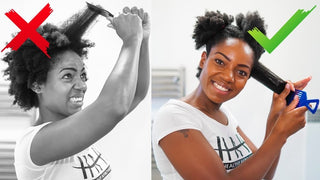For naturalistas, detangling dry hair can be a daunting task. The process can result in hair breakage, split ends, and hair loss. However, it is important to detangle matted hair to prevent these issues from occurring. In this article, I will share effective methods for detangling dry hair without causing damage.
Section your hair
The first thing to do when you want to detangle your hair is to section your hair. Trust me; this simple step will greatly impact your detangling experience. By sectioning your hair, you make it much easier to detangle each area instead of getting overwhelmed and trying to detangle all of your hair simultaneously.
Moisturize your hair
Moisturized hair is key when it comes to detangling. Why? Well, when your hair is well-hydrated, it becomes more elastic and easier to work with. On the other hand, bone-dry hair can be a real pain to detangle, and you may end up experiencing excessive hair breakage.
To make things easier, grab a spray bottle and lightly dampen your hair with water before you start detangling. This will help you glide through those tough tangles more smoothly. Just remember not to detangle when your hair is dripping wet, as your strands are weaker and more prone to breakage in this state.
Finger detangle your hair
One of the gentlest and most effective ways to detangle natural hair is using your fingers. To finger detangle, use your fingers to gently work through the knots and tangles in each section of your hair. Take it slow and be patient, as rushing can cause breakage and damage your hair.
Work your way from the ends of your hair to the roots, gently separating any knots and tangles as you go. If you encounter a particularly stubborn knot, try using your fingers to gently pull it apart or use a wide-tooth comb to help ease it out. Remember, be gentle and take your time; you'll have beautifully detangled hair in no time!
Use a comb
After you've finished finger detangling each section of your hair, you can use a wide-toothed comb to further detangle your hair. When using a comb, gently comb through your hair's ends and work your way up to the roots. If you encounter any tangles or knots, stop and gently work them out with your fingers before combing through your hair. Remember to be patient and gentle throughout this process to avoid causing any damage to your precious hair.
Alternatively, if you prefer not to use a comb, you can continue to finger-detangle until your hair is completely tangle-free.
Detangling from tip to root
When detangling natural hair, working from the tips to the roots is important. Starting at the roots can cause knots and tangles to gather at the tips, leading to breakage and damage. So, begin by taking a section of hair and gently working through any tangles at the ends before moving up toward the roots.
Twist or braid
Once you have detangled a section, you can twist or braid it to separate it from the rest of your hair. This will prevent it from getting tangled again while you work on other sections. Repeat this process for each section of your hair until you have detangled your entire head. Before twisting or braiding, you should also apply leave-in conditioner and hair serum to keep your hair moisturized.
Be patient
Lastly, but most importantly, be patient throughout the detangling process. Detangling natural hair can be time-consuming and require a lot of patience. Rushing through the process can cause more harm than good, leading to breakage and damage.
Take your time, gently work through each section of your hair, and be kind to your hair. Remember that your hair is delicate and needs to be treated with care. If you encounter a particularly stubborn knot or tangle, take a break, spray with water or add leave-in conditioner, and try again later.
